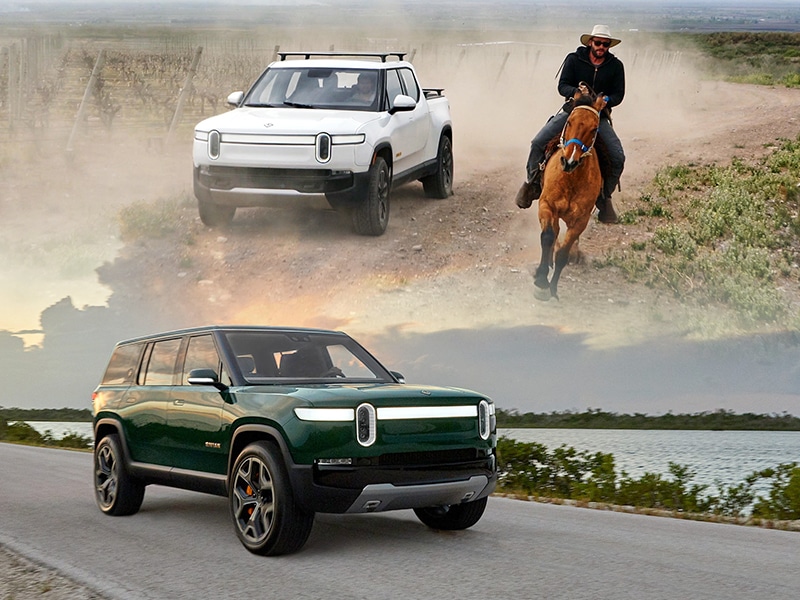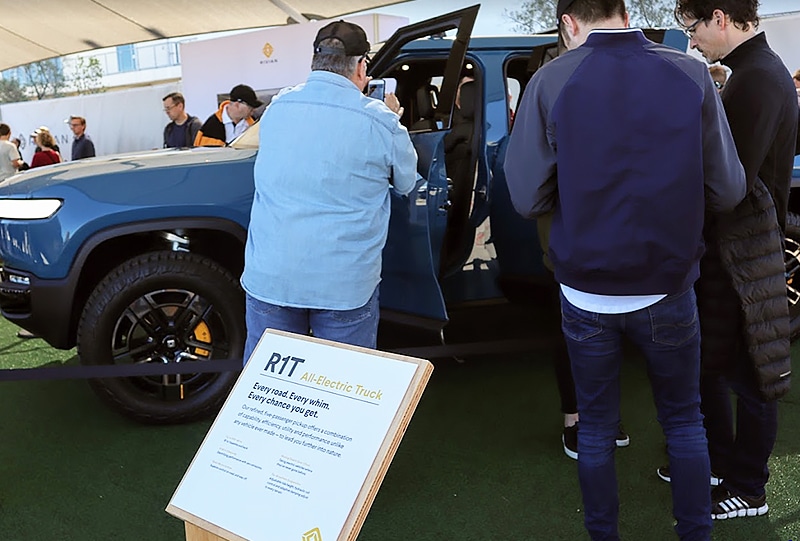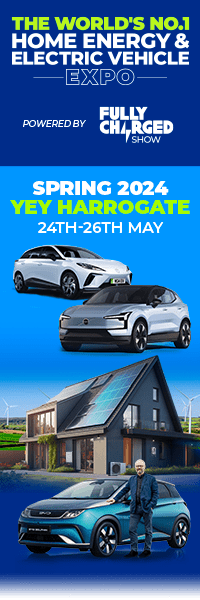
Rivian’s Third Car Should be a City Car
Rivian is on its way to deliver two important Battery-Electric Vehicles (BEV) to the American market: a mid-size pickup truck and a three-row SUV. Those are the two American car categories offering minimal BEV options to consumers.
After attending Fully Charged LIVE USA this winter, I believe a city car is where the new automaker should go with its third vehicle. That may seem off given the company’s first platform for large vehicles, but it makes perfect sense. Rivian is producing cars that fill holes in America’s EV market.

Interested attendees at Fully Charged LIVE USA peer into a Rivian R1T on display
If you need a people and stuff-hauler as a family, your best bet right now is the Plug-In Hybrid (PHEV) Chrysler Pacifica. A lot of people don’t want mini-vans and the FCA brand may not exist in a few years, it makes four cars right now and three of them are the Pacifica. If we include luxury automakers, you can fit a cramped third row into the Model Y or EQC. But, why would you want to? This is America! Our teenage children have long legs and require plump third-row space.
Rivian’s R1S meets the same market as the Ford Explorer, Chevy Suburban, and Honda Passport.
Rivian’s R1S debuts as America’s first really good BEV pick-up. It’s mid-size by U.S. standards but was not short on bed space with a 5-seat cabin. Ford is developing a BEV F150, America’s famously popular pickup, but I’m a skeptic of the company’s effort. I’m old enough to remember the electrified Ranger that Ford recalled off the market. Tesla CyberTruck was a hot conversation topic at Fully Charged LIVE USA, but so far it’s not clear if that vehicle will ever be sold. For a reasonable purchase price to mass-market consumers, pick-up driving Americans attempting the EV transition wait on the category’s incumbent leaders. You know, the companies who make buckets of money selling ICE pickups?
I think I share a common frustration with American EV fanatics: We loved that Fiat sold the 500e in America and we celebrated that Smart sold an second-generation ForTwo here. But, we couldn’t justify the purchase price of either. We hate that the two companies gave up on selling them. But, both were problematic: 500e a modified 500 with nasty chargeport faults and the ForTwo never got passed the 50 mi EPA range.
As a transportation reporter and an urbanist, I don’t like luxury cars and I’d rather you not buy a car at all. I remember with rage at the pedestrian dangers of metastasizing autos. However, I’m the son of a Big Three automaker employee raised amid suburban sprawl. I know good and well that cars are necessary for most American families and that we’re decades-way, at best, from plentiful public transport for most people in the U.S.
My goal here is for Americans to buy electrified cars, to give up the 2nd or 3rd vehicle in their garage, and to buy smaller cars with greater flexibility and functionality. I want Americans to buy BEV city cars for commuting and school runs. For larger families and longer trips, there’d be BEV SUV sharing the carport space. Rivian should make an R1C for “city” or “commuter” to sit next to the R1S.
Let’s assume the global pandemic delays, rather than derails Rivian. Let’s say the Plymouth, Michigan company is ready to sell a third model 3-5 years from now? I’m arguing, asking, pleading that Rivian makes something better for the EV-tempted Yankee car buyer. I believe the greatest opportunity is a city car for an affordable price and value specs. Both descriptors there are critical.
The 500e and Smart Smart ForTwo attracted such a small part of Americans because they offered crap specs and caviar prices. $27,000 for 50 miles of range? $33,000 for a compliance car-sized battery and a faulty charging port? And they’re only sold in California and maybe the handful of American states with stronger auto-emissions requirements and EV grants? Once Rivian delivers enough of their first models, the company could easily deliver a better option to all 50 states.

Second-generation BEV Smart Fortwo, parked on a street in Washington, DC
I believe “table stakes” are the capabilities of Fiat’s brand-new 500e model selling soon in Europe: 125 mi WLTP range, 80 KW charging, and actively-cooled battery. FCA haven’t announced full pricing yet, but I imagine it will come at a premium to VW’s new Mini Cooper SE. New is a charitable term there, it’s a parts-bin i3 with less range. Rivian have a golden opportunity to build a medium-priced city car, with beyond-range anxiety specs: enough to convince the Jones family to downsize and electrify with their second car.
I spoke with many Rivian employees at Fully Charged LIVE USA and my impression was that the technical innovations in software were key to a medium price point and mass-market adoption. I’m no Sandy Munro, but brains determine viability when you hold energy density and supply chain constant. Rivian may beat Tesla on both of the latter, but I think advanced driver assistance and safety would be key to a successful R1C. Rivian could deploy those smarts to every trim level while figuring the physics of the smaller platform. The R1C could be the first almost-driverless city car thought up by the sci-fi futurists at Google. The 500e didn’t have blind spot warnings!
It’s not that American’s won’t buy a city car. It’s that Americans have rarely been offered a good city car at a reasonable price. That’s been true of petrol cars and BEVs so far. Please, build one Rivian. Or, have an importer/exporter sell me the new 500. Or, convince the following automakers to sell the following small, high-value European cars in America: VW e-Up! (& re-badged sisters), VW ID3, Renaut Zoe, Peugeot e-208 (or Corsa brother), and Honda e.
About the author
Gordon Chaffin is a reporter for Street Justice, a news organization covering transportation, energy, and infrastructure throughout the Washington, DC region. Street Justice produces a free, weekly digest on Sundays covering national trends. Weekday reports include a reported story, a calendar of civic meetings, and a list of projects open for public comment. To submit a pledge for a subscription, click here.





